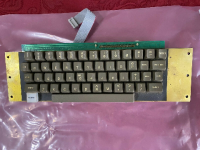I considered doing a clone with current-production CMOS logic, but aren't sure what to replace those huge shift registers in the video generator with. I assume when Woz designed this thing those registers were cost-effective alternatives to then available parallel SRAM. There can't be any other valid reason for hobbling the capabilities of the video display by choosing to design with what is effectively serial memory.
I could serial-ise modern parallel SRAM with address counters and I/O control logic to emulate the function of those original shift registers, but it would all look rather inelegant in the end, with a significantly higher chip count than an otherwise straight-forward and much superior memory-mapped design.
One could just emulate the whole video generator with a suitably fast modern micro-controller, but then it becomes just another embedded project lacking much of the retro appeal.
I could serial-ise modern parallel SRAM with address counters and I/O control logic to emulate the function of those original shift registers, but it would all look rather inelegant in the end, with a significantly higher chip count than an otherwise straight-forward and much superior memory-mapped design.
One could just emulate the whole video generator with a suitably fast modern micro-controller, but then it becomes just another embedded project lacking much of the retro appeal.



